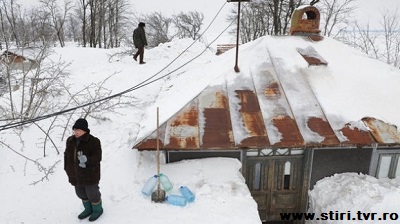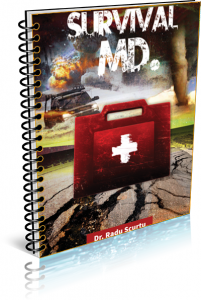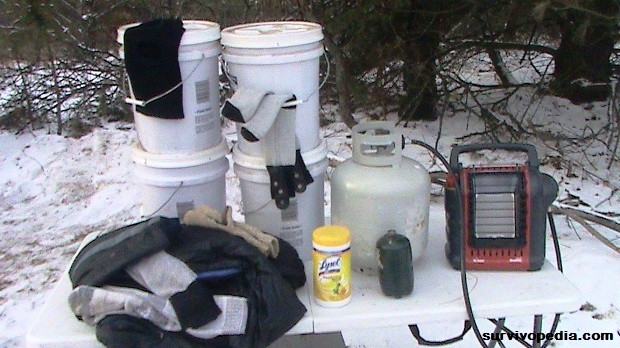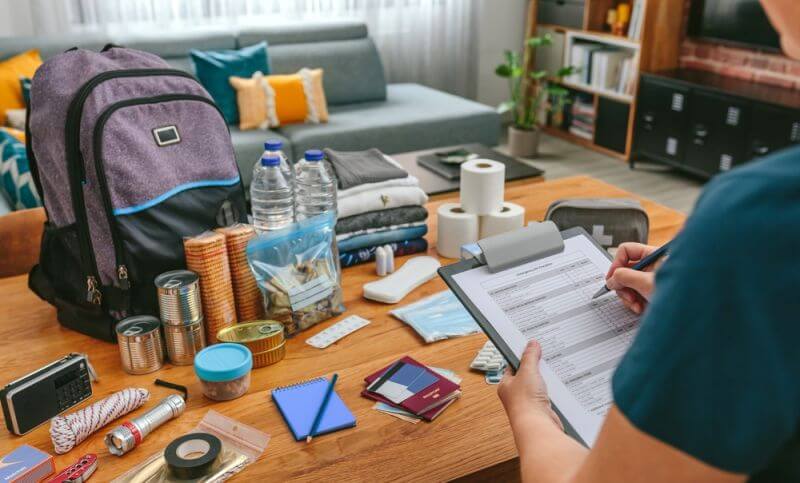Bad weather systems are some of the most common emergency survival situations. Snowstorms are probably the most overlooked because for the most part they are just the winter version of rainfall, and these are normal occurrences in our lives.
The problem is that regular ‘normal’ occurrence gives people the false sense of security that inures them to the dangerous insidious potential that can quickly hurt them. It happens especially in the case of very severe snowstorm, which belie their seriousness compared to the more dramatic results of hard rains and flooding.
Why Are Snowstorms so Dangerous?
In warmer bad weather you mainly worry about wind damage and traveling through flooding. If you can avoid that, you’ll likely make it afterward. Bad snow storms have an additional threat of freezing cold, and this situation will kill swiftly and mercilessly.
Also, unlike a head on hurricane or tornado which always starts bad and ends bad, most people don’t experience the worst effects of a bad snowstorm until just after it ends. In fact, as we’ve seen this week on the East Coast, it is difficult to predict with absolute certainty the severity of a snow storm in your precise location.
New York City was supposed to get 3 feet of ice and snow but it didn’t. A slight last minute shift in atmospheric conditions moved the storm further N/E. So any snow that starts falling cannot be absolutely guaranteed to be only a light dusting, or a monster drift burying nightmare with massive accumulations.
Fortunately if you are already inside a dwelling when the snow starts falling that’s half the battle. Surviving if you are outside in the wilderness is a bit more complicated and a different study. Shelter is a first priority in any event and if you are in your apartment and ‘prepared’, you should have no problems, right? Well, in an ideal world, perhaps.
But that’s not exactly the way it went down just this past week in parts of the Massachusetts area like Nantucket and in upper state New York and elsewhere on the upper East Coast, that got blasted with a high wind travel crushing blizzards dumping almost three feet in areas.
By the very large last minute mad rush to ‘prepare’ for what was being forecast as one of the worst possible storms in years. Panicky ’last minute’ people literally wiped out many small local food stores leaving news pictures showing nary a cracker crumb left on all the shelves, apparently not very many were ready and confident about their survival abilities.
I learned a long time ago to never ever underestimate the surprising beat down power of Mother Nature so the wisely prudent person should always keep enough supplies to get you through a few stormy days in life, that are never a matter of ’if’, but always a matter of only ’when’.
Somehow too many are still not getting it’. But they should, because a winter blast from Mother Nature can often be much more insidious and lead to a rabidly declining scenario if you don’t take the extra steps to prevent it. Remember, it’s not necessarily just the ‘amount’ of snow that accumulates, it’s what that accumulation sometimes causes.

Apparently it didn’t do that much damage or cause many injuries because it was never on any of the prime time TV news report here in the states.
That means that either they were prepared better or their life styles and location was more ‘suitable’ for this type of snowstorm so it really wasn’t that big of an ’event’.
We have places like Colorado and the mountains where snow falls of over 6 feet are pretty common and people ‘compensate’ and adjust their lifestyles and get ’used’ to it. But in a compacted mega-metropolis like New York City large snowfalls almost always cause very costly problems and put people in harms way. And when accumulations get around 3 feet and average vehicles cannot make it through the streets it starts to get dangerous.
Underestimating the Power of Snow
It never fails to amaze me when there are days of early forecasts and warnings of severe storms and invariably there are always numerous reports of people who become ‘stranded’ in the snow somewhere on an impassable road. and get in serious physical trouble with frostbite or dehydration. Why would anyone with any common sense left in their brains intentionally drive in dangerous conditions they were warned about in plenty of time to avoid!
I guess the answer might be obvious if you’ve ever seen ‘Waters’ World’ on the Fox News Channel.
Snowstorms are not considered TEOTWAWKI events (yet?), and many preppers don’t reference them in an advanced ‘Bug Out’ scenario because most snow storms are local, they eventually get under control and things return to normal relatively soon. So most people are able to ‘ride out the storm’ by sheltering and prepping in their homes.
It still wouldn’t be a bad decision to head out to your cozy ‘get away’ cabin in the hills for a while (especially if you lived in Marshfield MA during this week’s storm) with it’s wood burning fireplace and tons of cut and split firewood on the porch, a nice Generac auxiliary off grid power supply, a well stocked ‘root cellar’ completed with a good video movie collection and all the libation you’d need to snuggle up and relax with…
But most of us are not quite ‘there’ with our survival plans yet. So we’ll focus on those of us who have less than optimal options and show you the best set up for surviving a bad, but short term snowstorm especially in an urban city environment. It will also be the least expensive snowstorm prep that almost anyone can afford and quickly put together.
Videofirst seen on The New York Times.
The worst case scenario of storms are power outages, and subsequent heavy snow blockage of emergency resource response, and almost impossible conditions to facilitate speedy repairs.
Which is exactly what is still happening in some areas of this recent New England area storm, even though the municipal government took all preventative measures to err on the side of precaution. They even got to the point of receiving criticism for being too ‘heavy handed’ in their emergency preparations and demands by closing down virtually every business and public entity to facilitate rapid clean up response.
I don’t see anything wrong with that. It falls into the old logic that it’s better to be adequately prepared and not need it, then to not be prepared when a disaster happens!
So there were literally thousands persons on the East Coast especially New England without normal power company electricity and unable to drive out anywhere else because of the heavy snow. The entire Island of Nantucket was totally snowed in and WITHOUT POWER! And you know there were quite a few of the people there without enough food and freezing. I hope they pull together and hold on until help arrived, and I hope it arrived soon or they at least got the power back on before this next ’insult to injury’ storm is predicted to follow up and pound them again!
Reports show that most of the snowstorm casualties are those who thought they could drive around during hazardous snow storm blizzard conditions. The rest became victims of freezing temperatures and absence of supplies especially water and food.
It’s like bugging out when it’s too late and all the streets are cluttered with dead and burning cars and trash and who knows what else all conspiring together to make for a very un-smiley face day. That’s just stupid. DON’T be stupid. Instead follow these few simple precautionary solutions.
WHAT TO DO TO SURVIVE
1. Don’t Go Anywhere in a Blizzard. Especially Driving.
With maybe the exception of medical emergencies or checking on a friend or neighbor a short distance away by foot to see if they’re okay, stay home and watch the storm on TV if you still have power, or read a good survival book by candle light if the power is out. There are very few, if any, ‘ports in a storm’ out there in a bad snowstorm.
You’re already docked and secure in your house. If you go out looking for trouble, you’ll have no problem finding it.
2. Water and Food
No details necessary here. This goes without saying for anyone whose been ’into’ prepping for a while, and paying attention to Survivopedia messages.
But most people will still wait until the last minute. If you’re one of the latter, and you ‘forgot’ to go shopping ahead of time, I hope you at least have some cracker or a couple cans of spaghetti hiding in the corner of one of your cabinets to hold you over for a while. But you should have at least a week’s worth of food on hand for a snowstorm.
And if the storm started already, making it too dangerous to go anywhere, you can always do something like fill up your bathtub and/or pots and any containers with water for drinking before the power goes off.
3. Warm Clothing
Most of us do have enough clothing to keep warm when it’s cold if we live in a seasonal climate but the often overlooked items are socks and gloves, scarfs.
It wouldn’t hurt to have at least one pair of those nice super insulated cold weather snowmobile or hunting socks if you anticipate a situation colder than normal in your home. They cost around 20 bucks but you’ll really only need one pair because you can use a regular pair underneath.
You can even buy battery heated ones, or those usually orange colored dry heat packet inserts you see sold everywhere to slip in between pairs of socks. Your toes will send you little thank you love notes under the covers for that.
Layered clothing is best, and blankets on top of that. But a good snowmobile suit and arctic level boots are even better if you have the money.
4. Sanitation
This may not sound like that big of a deal to worry about in a bad snow blizzard, but when the power lines are down a lot of times it affects your water pump if you’re on a well pump system or an apartment complex where it needs electric pump pressure to reach the appropriate head level giving you water pressure out of your faucets and into the toilet for flushing.

And like Dr. Radu Scurtu points out in his Survival M.D. Guide, the most dangerous enemy to survival is disease brought by unsanitary conditions. (By the way, this medical guide is a ‘must have’ for any serious prepper.)
If the power isn’t coming back on for the foreseeable future or more than a couple days, don’t jam up your toilet with waste. Simple plastic garbage bags, preferably heavier duty, inserted in your commode seat and tied up and removed and replaced immediately after usage will work well enough. You can put the ‘doo doo’ bags outside in the snow then for later disposal. Camping supply stores have all kinds of similar systems and ‘porta-potties’ if this becomes a major concern.
For daily personal hygiene have a container of wet sanitary wipes sold everywhere for a couple bucks at dollar stores and if your skin is sensitive they have the ones used as diaper changing baby wipes which are not that strong.
5. Emergency Heat
Last but not least is the need to keep warm. In fact it’s really your first concern in a bad snowstorm because if you don’t have HEAT and you’re trapped by the snow you can die or lose body parts in hours, even minutes in some extreme cold and ice conditions.
When the power in the neighborhood goes out during a storm which seems to be the case in virtually EVERY heavy storm lately, if you have electric baseboard heat or a standard forced air gas furnace, guess what? Yup, you guessed it: they won’t be working.
If you have a wood burning fireplace or even a natural gas, or better yet propane, one, then as long as you have fuel under pressure in the lines, or dry wood stacked on your porch or deck, you can light your fireplace and hang around that. (don’t forget to open the flue in the chimney!)
But please don’t use your so called high efficiency ‘gassifier rocket stoves’ in your apartment living room or bedroom just because it appears to burn cleanly without much smoke and you have a lot of old newspapers and magazines you’ve been wanting to get rid of that you can burn! Without adequate ventilation, it still gives off enough carbon monoxide of a potentially dangerous level. Unless your ‘stove’ or heater is rated at 99% plus efficiency it will be giving off some amount of potentially harmful carbon monoxide which you don’t want for any length of time. And don’t be super stupid by running a gas generator in your bathroom, either.
On the other hand, if you have a gas flame burner kitchen stove hooked up to an outside propane tank, and when you turn it on the jets create a mostly blue colored flame, then that’s burning pretty efficiently and it would work somewhat safely in an emergency like a small output fireplace if you turned it off intermittently if that’s all you had, even without the exhaust fan working.
But a lot of people don’t have a fireplace so in the picture here of the basic items needed I included one of the best all around small portable heaters for just such emergencies. These evolved from the ‘trickle-up’ of ice fishing shanty heaters and are quite popular now for various ancillary zone heating needs in cold climates. There are various brands and sizes sold almost everywhere and can be ordered off he internet and delivered.
I’ve tried out and used different ones over the years in cold climates and I think the best bang for the buck which will keep you from emerging from a storm without the loss of toes, nose, or fingertips is the new Mr. Heater ‘ Portable Buddy’ model. It costs between $120 and $150., depending upon gouge level of your store and location.
The thing about these slick little heaters is that they throw out a lot of British Thermal Units (BTU) for their size, which is a standard measurement of heat intensity. You can get larger or smaller ones but The ‘Portable Buddy’ model puts out around 4 to 8 thousand BTU’s either low or high setting and this is enough heat to keep a 300 sq ft. Room at a comfortable 60 or more degrees depending upon your wall insulation when it’s below zero outside.
Sitting closer to it, of course, will be warmer. The burning surface is of the ‘catalytic’ configuration which just means that it burns without a visible dancing flame outside of the very small pilot light/flame cleaner and more efficiently giving you better mileage out of your propane tanks.
These Portable Buddy heaters have virtually no smell or noise during operation, and always start instantly when gas is connected and on. And they are rated for inside usage and have an O2 sensor which means If the room is too air tight it shuts itself off at a certain oxygen depletion level so you can still breathe. It also instantly shuts itself off if it accidentally tips over .
For max portability they use the small green one pound tanks, which last maybe 4 to six hours. But with a hose adapter for about $25 bucks at Walmart or online, as shown in the picture, you can hook up a 20 or 30 pound portable barbecue grill propane tank and it will actually run constantly for an amazing 100 or more hours! That’s more than four whole days without even conserving the duration by not having it on all the time if it’s not that frigid.

So there you have the least expensive and simplest requirements to survive a bad snowstorm for someone of minimalist living circumstances especially in an apartment environment.
Total cost of the items in the picture which includes a couple weeks worth of food and water for one person is around $300 bucks which is not much when compared to the essential value and prep comfort and potential life saving they provide. That set up could keep you going for at least a week trapped without power in a bad boy ‘Nor Easter’. You can easily fit what you see there in the corner of a closet or even in a small car.
There’s always more that you can do to prepare even better for snowstorms if your area happens to have a lot of them every year if you need to. They seem to be getting worse–or rather back to the way it was a couple generations ago when the population and congestion was less. Winter storms have been pretty hard and heavy especially in the N/E Coast the last few years where the results of the ‘chem-trail’ weather control experiments in the Midwest under the Jet Stream inevitably blow the ‘experiment’ to the East Coast. Maybe it’s political?!
Advanced Survival Technology can make almost any storm an uneventful personal experience depending upon your resource budget. But everybody should be able to follow these basic essential tips easily enough. If you do, you can ‘ride out the storm’ in relative comfort and safety. You’ll even be able to sing the song…’Let it Snow, Let it Snow, Let it Snow!’
This article has been written by Mahatma Muhjesbude for Survivopedia.









gritch | February 1, 2015
|
Keeping your heat going during a power outage:
If you have hot water baseboard gas fired heat, as I do, it’s rather easy to make a backup power setup for it.
The electrical items in this kind of system are:
A circulating pump, commonly 1/12 horsepower
One or 2 small transformers-usually 2 if you have zone valves.
An inverter, a cheap one from Harbor Freight will do, of at least 1000 watts capacity, and an automotive battery-I usually change mine every 5 years whether it needs it or not, and save the old one, which is still good enough for running the inverter. Find the power input to the heating system and install a DOUBLE POLE DOUBLE THROW switch of at least 15 ampere capacity. Connect the wires from the boiler system to the CENTER contacts on the switch, and the incoming house power to one pair of side contacts, and wires to the inverter on the other side pair. Mount this in a proper junction box. Now if the power fails, just throw the switch to the inverter side and start the inverter.
The battery should have a trickle charger connected to it (Harbor Feight sells these) to maintain charge in normal (power on) times.
If you want a little better system, buy a new deep discharge marine type or electric wheelchair type battery, instead of the hand-me-down car battery.
If you have oil fired heat, or hot air heat with a blower motor, your electrical requirements will be heavier. Consult a heating guy for requirements.
I have had this system in place for several years, and have used it several times.
I have a 10 KW Generac, but running that all night just for heat is a waste and causes extra wear on the generator and noise at night.
I also have my refrgerator plugged into a readily accessible outlet so I can pull the plug out and easily connect an inverter
Pingback:Snowstorm Survival - Patriot Rising | February 1, 2015
|
kevin | February 2, 2015
|
to use a VERY old line proper planning prevents piss poor proformance
Pingback:Snowstorm Survival: 5 Steps To Stay Safe | TheSurvivalPlaceBlog | February 4, 2015
|
Pingback:Prepper In Boots. What Kind Of Boots? | Survival skills, survival guns, survival guide | February 19, 2015
|
Pingback:Prepper In Boots. What Kind Of Boots? | The Prepper Dome | February 19, 2015
|
Pingback:Prepper In Boots. What Kind Of Boots? | TheSurvivalPlaceBlog | February 20, 2015
|
Pingback:Survival Lessons From The Pioneers: The Donner Party | Prepper's Survival Homestead | May 6, 2016
|
Pingback:Survival Lessons From The Pioneers: The Donner Party | | disasterdefense.us | May 6, 2016
|
Pingback:Survival Lessons From The Pioneers: The Donner Party | Survivopedia | June 8, 2018
|